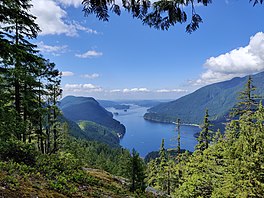| Indian Arm | |
|---|---|
| Halkomelem: səl̓ilw̓ət | |
 A southward view of Indian Arm, taken along the Dilly Dally Loop Trail in Indian Arm Provincial Park | |
 Satellite photo of the Vancouver region; Indian Arm is in the upper right corner. | |
| Location | North Shore Mountains Vancouver, British Columbia, Canada |
| Coordinates | 49°22′37″N 122°52′41″W / 49.37694°N 122.87806°W |
| Type | Fjord |
| Part of | Burrard Inlet |
| Primary inflows | Indian River, Coquitlam River via Buntzen Power Plant |
| Max. length | 20 km (12 mi)[1] |
| Max. width | 0.5 to 2 kilometres (0.31 to 1.24 mi)[2] |
| Average depth | 120 metres (390 ft)[1] |
| Max. depth | 218 metres (715 ft)[1] |
| Islands | Twin Islands, Croker Island, Racoon Island |
| Settlements | North Vancouver Belcarra |
| References | [2][1] |
Indian Arm[3] (Halkomelem: səl̓ilw̓ət[4]) is a steep-sided glacial fjord adjacent to the city of Vancouver in southwestern British Columbia. Formed during the last Ice Age, it extends due north from Burrard Inlet, between the communities of Belcarra (to the east) and the District of North Vancouver (to the west), then on into mountainous wilderness. Burrard Inlet and the opening of Indian Arm was mapped by Captain George Vancouver and fully explored days later by Dionisio Alcalá Galiano in June 1792.[5][6]
- ^ a b c d Nijman, R. A. (1994). Coquitlam-Pitt River Area, Burrard Inlet : Water Quality Assessment and Objectives (PDF). [Victoria]: BC Environment, Water Quality Branch. p. 10. ISBN 0-7726-1739-2. Retrieved 9 April 2023.
- ^ a b "Indian Arm". letsgoplayoutside.com. Retrieved 9 April 2023.
- ^ "Indian Arm". Geographical Names Data Base. Natural Resources Canada. Retrieved 2020-06-16.
- ^ "səl̓ilw̓ət (Sleilwaut) - Burrard Inlet/Indian Arm (Tsleil-Waututh) - The Bill Reid Centre". Simon Fraser University. Retrieved 12 June 2021.
- ^ Kendrick, John (1990). The Voyage of Sutil and Mexicana, 1792: The last Spanish exploration of the Northwest Coast of America. Spokane, Washington: The Arthur H. Clark Company. p. 133. ISBN 0-87062-203-X.
- ^ Roberts, John E. (2005). A Discovery Journal: George Vancouver's First Survey Season - 1792. Trafford Publishing. pp. 126–129. ISBN 1-4120-7097-X.

